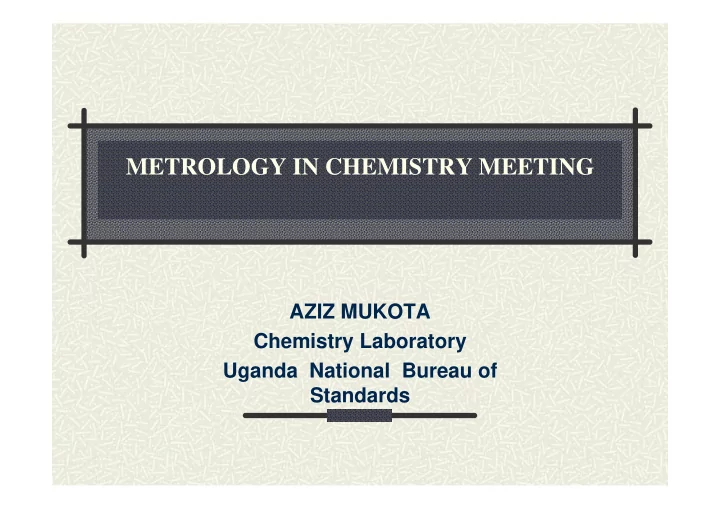

METROLOGY IN CHEMISTRY MEETING AZIZ MUKOTA Chemistry Laboratory Uganda National Bureau of Standards
Presentation Outline Uganda UNBS National Metrology Laboratory Chemistry Laboratory Proficiency test for ethanol Measurement uncertainty
About UGANDA
Uganda National Bureau of Standards A statutory body under Ministry of Tourism Trade and Industry established by UNBS act of 1983 Became operational in 1989 Governed by the National Standards Council and headed by the Executive Director
THE UNBS MANDATE The mandate of UNBS is to develop and promote: Standardisation, • Quality Assurance • Laboratory Testing • Metrology • In order to; • to enhance the competitiveness of local industries • to strengthen Uganda’s economy and to promote • quality safety and fair trade
MISSION AND VISION THE UNBS MISSION To enhance national development through the • application of standards in trade, industry and consumer protection THE UNBS VISION To be a leading institution of international repute in the • provision of standardization services
STRUCTURE OF UNBS Executive Director heads the UNBS. Two heads of Directorates support the Executive Director: Deputy Executive Director Technical Operations (TO) and Deputy Executive Director Management Services (MS). Uganda two directorates; Technical directorate has 5 departments; Standardisation, Quality Assurance Laboratory Testing Legal and Industrial Metrology
National Metrology Laboratory Uganda has a National Metrology Laboratory situated at UNBS headquarters where primary standards used for physical measurements in the domains of volume, mass, pressure, dimensions and temperature are kept. The national standards are well maintained and serve as the sources of traceability for the associated physical quantities in the country. The Metrology department has three divisions Mechanical division Mass Lab Volume & Flow Lab Pressure Lab Dimensions Lab Thermodynamics Thermometry Lab Density & Viscosity Lab Instrumentation Electrical lab Maintenance The metrology in Chemistry is at the moment is being managed by the chemistry Laboratory in the Testing Department
UNBS-Chemistry laboratory The chemistry laboratory falls under the Testing Department which has 5 Laboratories under it which include; Microbiology, Electrical, Materials Engineering , Petroleum and Chemistry. The chemistry laboratory provides testing services for conformity assessment to help prevent contaminated and adulterated foods and non food products from entering the market . The lab tests various food and non food products from; Imports, locally produced, research , standards formulation, tender evaluation, market surveillance etc. The services provided also enhance the quality of the various products manufactured in Uganda, by providing the industries with advice, information and test results on the quality of their products. The laboratory carries out training in analytical skills to students from universities and industrialists.
Chemistry laboratory structure Chemistry lab NON- FOOD CHEMISTRY QUALITY ASSURANCE RESEARCH AND DEVPT/ CHEMICAL METROLOGY FOOD CHEMISTRY Proximate Building Materials Additives Textiles Water Cosmetics Alcohols Industrial Chemicals Edible oils Consumer products Proficiency tests Soft drinks / juices etc Method validation Food Contaminants Pesticides, heavy metals etc. Estimation of measurement Uncertainty IQCS Records etc
Status of Metrology in Chemistry The concept of metrology in chemistry has not yet been well perceived in Uganda. Proficiency testing schemes and implementation of quality management systems based on ISO/IEC 17025 is being practiced by some laboratories since the standard emphasizes validation, measurement uncertainty and traceability of measurements. Two sensitization workshops have been carried out regarding metrology in Chemistry. During The world metrology day celebrations Annual International Standards Conference.
Status of Metrology in Chemistry Chemical measurements support decisions on food safety, health and environmental protection in Uganda and thus find applications in - Regulatory bodies - Health sector - Industrial sector - Research - Educational sector - Forensics - Pharmaceuticals -e.t.c -There are various labs in Uganda performing chemical related mesurements
Accreditation status The National Metrology laboratory Mass Laboratory is accredited by SANAS The Microbiology laboratory is accredited by SANAS. The Chemistry Laboratory is due for initial Assessment by SANAS before the end of the year. Plans are also underway to have all other testing laboratories ( Electrical, Materials, Petroleum) at UNBS accredited.
Proficiency testing sample The sample was received well packaged with no defects A. Principle n-Butanol internal standard is added to sample, standards, and Methanol/ethanol were determined by GC using flame ionization detection. B. Reagents and Apparatus (a) n-Butanol - assay 99.88%. (b) Methanol - assay 99.8% (c) Ethanol - assay 99.9% (d) Ethanol and methanol standard solutions. —Prepared by dilution of a concentrated stock ethanol standard at different concentration levels;
c. Equipment Gas chromatograph. — varian CP 3800, With flame ionization detector and with cipsil 8CB column of 30m, , 0.3mm internal diameter, 0.1µm thickness . N 2 Carrier gas at flow rate of 1mL/min; injector temperature 150°C;); detector temperature 200°C. column program Initial hold time Rate °C/min 40°C 5 minutes 1 °C/min 59 °C 0.0 20 °C/min 200°C 4.95
Calibration C. Calibration The following calibration levels for ethanol (1%, 2%, 8% v/v) and methanol (0.1%, 0.25%, 0.5% and 1% v/v) were prepared. 0.250µl of butanol internal standard was put into a 10ml volumetric flask and topped up with ethanol solution of the required calibration level and Mix thoroughly by swirling. 1 µl of each level of calibration standard solution and sample were Injected into the GC and peak areas were measured using an integrator. The principle involved Calculating ratios of ethanol to n-buta nol peaks. Plot ratio against concentration
Uncertainty estimation Validation data was still being generated for the method being used . Precision and purity data for the standards used was to be used to estimate the uncertainty
THANK Y THANK YOU ! U !
Recommend
More recommend